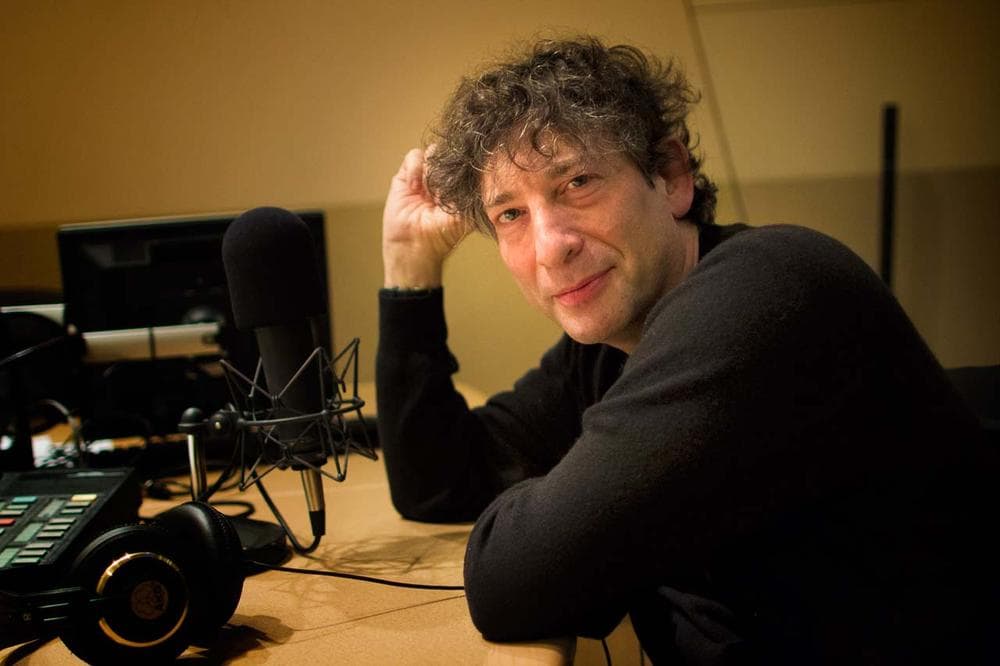Advertisement
Neil Gaiman, With A Meta-Take On Writing For Comics
Our Nov. 25 hour with Neil Gaiman had the rather lovely advantage of the comic book / fantasy / horror writer extraordinaire right here in our studios in Boston. (For the time being, at least, Gaiman maintains a house in the Boston area that makes WBUR studio visits a mere car ride away.)

Sitting in with our host, Tom Ashbrook, also gave Gaiman the opportunity to take a very meta approach to explaining the way a typical author might prepare for writing the words and actions in a graphic novel.
"I got to use the most wonderful artists in comics, and still with 'Overure,' I'm still having that as a privilege. Normally, the tradition with comics was that you would be an artist-writer team forever. For various reasons, Sam Kieth, who started 'Sandman,' retired early. he retired after issue five, and just said, he said, 'Look this is great but I feel like Jimi Hendrix in the Beatles, I'm in the wrong band.' He was taken over by a wonderful artist named Mike Dringenberg. Mike stuck it for another couple of years,but didn't like the monthly deadline thing. You have to sit there and keep drawing and keep drawing. I think it's bad as a writer."
"So Mike then retired and after that, we decided that it would be easier to find the right artist for the right story line, which was a complete break with tradition. So, for a story called 'Season of Mists,' which was big and grandiose and in Hell, I had a marvelous artist named Kelly Jones. For a story called 'Brief Lives,' which was much more human, much more just all about real people standing around talking, I used a fantastic artist called Jill Thompson. That was great because I walked away with all of these friends...there were probably a hundred people who worked on 'Sandman' during the course of those 75 issues."
"What you do, and this is something that I'd wanted to know since I was a kid. I was a kid reading comic books, as I read everything, and I particularly loved American comics, 'cause they'd come over to England and they were like postcards from Oz. They were just these strange, wonderful things, and I'd think, 'How do they get written?' I knew what a movie script looked like, I'd seen them . But I couldn't get my head around what a comic script was. And eventually, a marvelous comics writer, probably the finest writer of comics there's ever been, a man named Alan Moore just showed me how to write comics. He sat down and said, 'Right, right now, you write Page One, Panel One. And then you say everything that is happening in that panel.' In this case, you know, you'd say, 'Page one, panel one, Neil Gaiman and Tom Ashbrook are sitting in a studio, there's paper all over the desk, there are great big microphones. Neil is talking, waving his hands around, doing an impression of Alan Moore. Tom is nodding sagely.'"
"It's stage directions, and it's a letter to an artist. And then underneath, you'd write Tom: 'It's stage directions'; Neil: 'It's a letter to an artist' and those would be what would go into the word balloons. And Neil, thought balloon: 'I'm so glad they got me that cup of tea.' You put everything. As far as I was concerned, and still to this day, as far as I'm concerned a comic script is a 10,000 word letter to an artist. I would always get puzzled when people would say to me, 'So you write comics! So you write the words that go in the balloons.' And you're going, 'That's absolutely the tip of the iceberg.' What I'm doing is building the cake, and in those words I will tell the artist everything I want to be in the panel — the size of the panel, the shape. What you're also doing is working with some of the most creative people in the world."